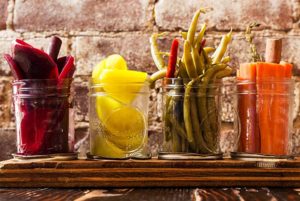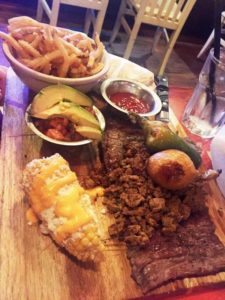Austin, Texas’ Top 10 Pickled, Cured, or Brined Bites (and Sips)
Nothing a little time and some spices can’t fix
BY ADRIENNE WHITEHORSE, FRI., DEC. 30, 2016 – AUSTIN CHRONICLE
1) Pickled Peanuts, Royal Jelly
Recently, Royal Jelly owner and chef Matt Walker thought to pickle groundnuts to give his Thai shrimp lettuce wraps a little more acidity and a slightly softer texture. On any given day, the Royal Jelly crew is concocting a new brine to play with. But that day had extra magic.
2) Fermented Green Tomatoes, Soursop
We love anything these guys throw in a salt solution, be it shoestring carrots and daikon on the roti tacos or Thai chiles for their top-secret hot sauce. But these tangy green tomatoes are stacked atop green-curry fried chicken for a sandwich that hits all the right notes. The food truck at the St. Elmo Brewing Co. combines savory, sweet, spicy, and acidic, resulting in flavor bombs that beg to be accompanied by a sip of crisp beer.
3) Probiotic Sauerkraut, Hat Creek Provisions
We sampled this crunchy kraut at last year’s Fermentation Festival and have had a healthy addiction since. Available at retail outlets like Wheatsville and Whole Foods, the lacto-fermented cabbage (never heated and without vinegar) is naturally full of probiotics for a healthy gut. So you understand why we sometimes – okay, often – eat it straight outta the jar.
4) Tuna Crudo, Lenoir
We recently celebrated a special occasion at Lenoir, and this olive oil-cured tuna, resting in ponzu with a delicate melon relish, was our favorite bite of the night. With the menu changing as often as Texas’ winter weather, we regret that this dish has likely already been retired; but we’re pretty confident something else equally stellar will have taken its place.
5) Fermented Tomato Bloody Mary, Emmer & Rye
Koji, a fungus used to ferment soy sauce and miso, is employed in several desserts at Emmer & Rye, including an apple syrup on the French toast at brunch. Not much surprises us from a restaurant that has a dedicated fermentation pantry. It is said that fermented foods will help hangovers; that’s just one of the reasons we love this umami-laden Bloody.
6) The Jolene, the Boiler Room
Pickled peach shares the stage with ginger beer, sun tea bitters, and mint in this vodka-based cocktail from mixologist Jason Stevens. The subterranean bar below the Seaholm Power Plant pays homage to famous musicians with its craft cocktail menu, and this Dolly Parton nod sings.
7) Smoked Salmon Deviled Eggs, Central Standard
This steakhouse’s beautiful presentation of cured, smoked salmon deviled eggs, topped with bright pink pickled red onion and “everything spice” is quite possibly one of the most Instagrammable brunch items of the year. Eaten together with one of the best steak tartares in town, our taste buds were pretty pleased as well.
8) The Hawaiian Rose, Cu29 Cocktail Bar
When the price of a cocktail veers into the double digits, it seems worth it to get a show from the bartenders performing their craft. With this coconut rum-based drink, a slice of bacon is torched in front of you, the fat dripping into a mixing bowl, which is then whisked into a whipped cream dream. This one is worth the wait.
9) Kimchi and Banchan, Mom’s Taste
Not quite a grocery store, this family-owned Korean mini-mart sells marinated beef and pork for cooking bulgogi at home, as well as a fantastic variety of banchan (side dishes) like soybean sprouts, seaweed salad, fish cake, and kimchi galore: radish, cucumber, napa cabbage, etc. If you’re feeling adventurous, try the peppered organ meats or the fried anchovy with gochujang. We love it all.
10) Charcuterie Board, Aviary Lounge
Aviary is everything we want in a wine bar. Intimate space (a home furnishings store by day), great selection of wine and beer, and a rotating list of meats and cheeses that is always thoughtfully curated. Even if they didn’t add Easy Tiger bread and house pickles, it would still be one of our favorites.




